'CForth' Forth interpreter for STM32G4xx and STM32F042
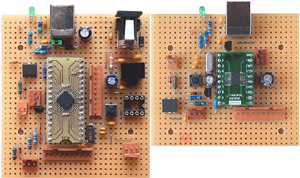 CForth is a 32 bit Forth interpreter system completely written in C language.
CForth is a 32 bit Forth interpreter system completely written in C language.The intention is to make a straightforward user oriented Forth system, specifically to organize interactive electronic control of art objects and installations or similar process control. Primarily the code was developed for STM32G431KB (LQFP32), but STM32G441KB is supported, too. Appropriate firmware versions for STM32F042 TSSOP20 and LQFP32 (also works with STM32F070) are provided. Veroboard compatible PCB designs are proposed. ...more |
'CForth' Forth interpreter for STM32F411 BlackPill and Nucleo-64 (STM32F411 or STM32L476)
 CForth is a 32 bit Forth interpreter system completely written in C language.
CForth is a 32 bit Forth interpreter system completely written in C language.The intention is to make a straightforward user oriented Forth system, specifically to organize interactive electronic control of art objects and installations or similar process control. Primarily the code was developed for STM32G431KB (LQFP32), but STM32G441KB is supported, too. Based on this source, modified firmware versions for STM32F042 TSSOP20 and LQFP32 (also works with STM32F070), for STM32L476 Nucleo-64 and STM32G431 Nucleo-64 are provided. Veroboard compatible PCB designs are proposed. ...more |
'CForth' Low Power version for STM32G431(G441), STM32F042(F070), STM32F030 and STM32L031
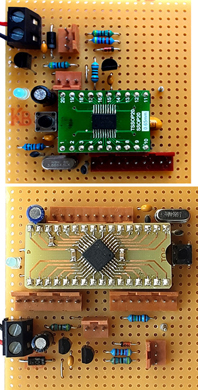 This special version is preferably designed for
This special version is preferably designed forinteractive control of dynamic objects powered by small solar panels or similar projects by means of the Forth programming language. The power reduction is essentially obtained by a low CPU clock. For this reason, USB is not available. Terminal access by RS-232 with baud rates up to 115200. Else CForth Low Power has almost the same features as standard CForth. Supported processors: STM32G431,G441,F042,F070: 0.921MHz, switchable at runtime to 3.6864/14.7456MHz STM32L031K6 (LQFP32) and STM32L031F6 (TSSOP20 new Jan'25): 1.048MHz switchable at runtime to 4.194MHz This interesting processor uses significantly less supply current than the others. STM32F030K6: 0.921MHz, switchable at runtime to 3.6864/14.7456MHz Special 48MHz version for STM32F030K6: with external 8MHz crystal or with internal HSI RC oscillator (new Feb'25). This low cost processor has only 4kB SRAM, only small user projects are supported. Appropriate hardware was developed under the aspects of saving power. Veroboard compatible single layer PCB layouts are available for download. ...more |
'CForth' for STM32C011J6 (SO8 case)
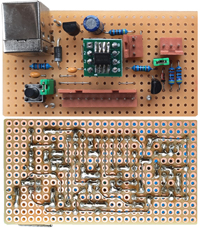 It is a little bit funny idea to create a Forth interpreter for such a tiny 8pin processor. The deeper reson below is to get a low level register based working platform for final development of simple, practically useable everyday tools.
It is a little bit funny idea to create a Forth interpreter for such a tiny 8pin processor. The deeper reson below is to get a low level register based working platform for final development of simple, practically useable everyday tools.For early development stages of standalone tools, the interactive handling and easy parameter optimization with such a minimal "high level" environment is helpful for me. The CForth interpreter was ported from my CForth Low Power projects. Some of the processors used there are internally organized very similarily. Firmware is supplied for 48MHz and 3MHz system clock. A Veroboard compatible single layer PCB layout is available for download. ...more |
Grey Pill = simplified Black Pill compatible PCB for STM32G4xx
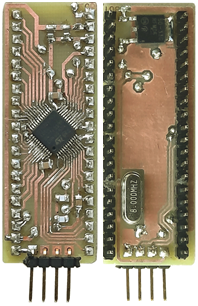 Pinout of the "Black Pill" module is very appropriate to be expanded by user specific circuits. Unfortunately it is not available with more attractive processors like ST32G431, STM32G441, STM32G474.
Pinout of the "Black Pill" module is very appropriate to be expanded by user specific circuits. Unfortunately it is not available with more attractive processors like ST32G431, STM32G441, STM32G474.
So I decided to build my own. With home-makers technology I could not integrate the USB connector, the reset button and BOOT0 button onboard. It is not fully "black" - for this reason, I call my design "Grey Pill". Reproduction of this board takes some skills and tools ...more |
|
'Avise' Forth interpreter for ATmga168/328, ATmega644/1284 / 32 and ATmega32U4 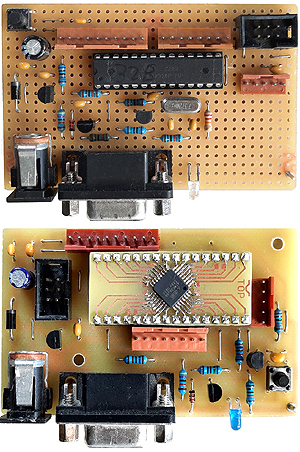 Inspired by 'CForth low Power', this Forth interpreter is designed for
Inspired by 'CForth low Power', this Forth interpreter is designed forsimilar projects by means of the Forth programming language. An essential reason for this work is that these 8 bit ATmega processors use less power at acceptable operation speed. In contrast to 'CForth', the project is completely programmed in assembler. User functions are stored subroutine threaded to get most speed of the ATmega. The power reduction is essentially obtained by a low CPU clock: 921.6kHz, switchable at runtime to 1.8432MHz or 7.3728MHz, depending on crystal, and terminal access by RS-232 (ATmega32U4 with USB COM interface). Optionally firmware versions for high CPU speed and optimized for Arduino Uno, Arduino Micro and Arduino Leonardo are provided. Appropriate hardware was developed under the aspects of saving power. Veroboard compatible single layer PCB layouts are available for download. ...more |
SPI I/O expansion board for CForth compatible hardware
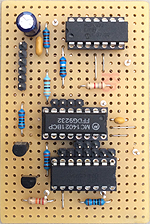 This SPI controlled circuit provides two 12 bit DAC, 8 digital IN, 8 digital OUT.
This SPI controlled circuit provides two 12 bit DAC, 8 digital IN, 8 digital OUT.
It can be operated with 3.3V supply or with 5V supply/3.3V logic level. A Veroboard compatible single layer PCB layout is available for download. ...more |
Pulse Generator to trigger Awake from Sleep
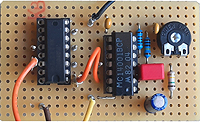 To be combined with Avise SLEEP command. Provides wake pulse - delay user configurable up to 90 minutes. Essentially an astabile multivibrator with additional time stretching counter.
To be combined with Avise SLEEP command. Provides wake pulse - delay user configurable up to 90 minutes. Essentially an astabile multivibrator with additional time stretching counter.Supply current approx. 7-28 Microamp. To be powered from ATmega board, supply voltages 3.0 to 5 Volt. A Veroboard compatible single layer PCB layout is available for download. ...more |
Simple Li-ion Charger
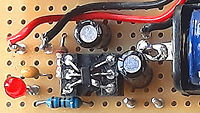 An easy to build Veroboard compatible design with MCP73831 charger chip.
An easy to build Veroboard compatible design with MCP73831 charger chip.
It can be operated with input voltages up to 6.0V (e.g 5V USB power supply) and is preferably designed for 14500 (=Mignon size) Li-ion accumulators. A Veroboard compatible single layer PCB layout is available for download. ...more |
"DTerm" terminal software for RS-232 and UDP
|
It is surely not the best terminal emulator, but has been developed over the years for best fitness with my actual projects. The present version 3.14 is optimized for interactive upload of scripts and source code, working together with the CForth and Avise projects. As a result of older projects, next to RS-232, Ethernet UDP terminal operation is supported. A lot of TCP / Telnet terminals are available, but tools for manual communication over UDP are rare. ...more |
Simple digital sine wave generator
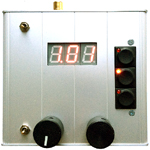 Construction of a simple digital wave generator based on Atmel ATXmega32A4 is described.
Construction of a simple digital wave generator based on Atmel ATXmega32A4 is described.The frequency range is 40Hz to 15.6 Kilohertz. With pushbuttons, three independent frequencies are selectable: default frequencies 5kHz, 1kHz, 200Hz, which is good for rapid test of audio circuits. The frequency of each button can be tuned over the full frequency range. The source code written in assembler language and schematic is published here. An additional charger for a built-in 9V block accumulator is described too. This way it is an ideal out-of-lab service tool. ...more |
![]()
![]()
* State of information December 2025.
* The hints presented here are for information only. No product features, specifications or useability are assured in juridical sense.
* All information based on best knowledge, but without any warranty. Any responsibility is excluded.
* Trademarks and product names cited in this text are property of their respective owners.
* Informationsstand Dezember 2025.
sie geben keine Zusicherung von Produkteigenschaften und -Tauglichkeiten im rechtlichen Sinne
* Alle Informationen nach bestem Wissen, jedoch ohne Gewähr und unter Ausschluß jeglicher Haftung.
* Im Text zitierte Warenzeichen und Produktnamen sind geschütztes Eigentum ihrer jeweiligen Eigentümer.